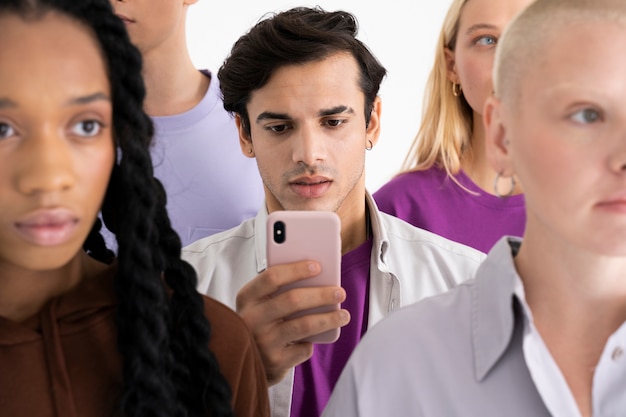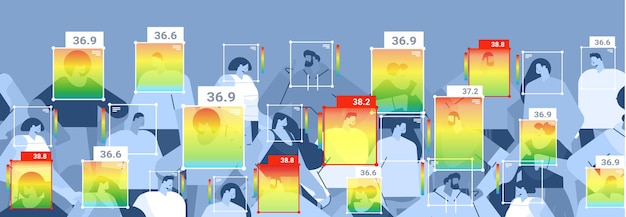Social Media & Political Polarization: Can We Heal the Divide?

Analyzing the impact of social media on political polarization reveals a complex relationship where echo chambers and algorithmic amplification exacerbate existing divisions, posing challenges to informed discourse and potential solutions for bridging the political divide.
The rise of social media has profoundly reshaped the political landscape, but is it a force for division or a potential bridge across the aisle? Analyzing the impact of social media on political polarization is crucial to understanding the current state of political discourse.
Understanding Social Media’s Role in Political Polarization
Social media platforms have become central to how we consume and share political information. However, their architecture can inadvertently amplify polarization. Let’s examine how these platforms contribute to the deepening divide.
Echo Chambers and Filter Bubbles
Social media algorithms often prioritize content that aligns with users’ existing beliefs, creating echo chambers where opposing viewpoints are rarely encountered. This can reinforce biases and lead to more extreme positions.
The Spread of Misinformation and Disinformation
The ease with which false or misleading information can spread on social media poses a significant threat to informed political discourse. This “fake news” can further entrench polarized viewpoints and erode trust in institutions.

Here are some key ways social media contributes to political polarization:
- Algorithmic amplification of extreme content.
- The creation of echo chambers that reinforce existing beliefs.
- The rapid spread of misinformation and disinformation.
- Reduced exposure to diverse perspectives.
In conclusion, social media’s architecture and content dynamics contribute significantly to political polarization by creating echo chambers, amplifying misinformation, and limiting exposure to diverse viewpoints.
The Psychology Behind Online Political Polarization
To truly understand the impact of social media on political polarization, we need to delve into the psychological factors at play. These platforms tap into fundamental human biases and tendencies, exacerbating divisions in the process.
Confirmation Bias and Identity Reinforcement
People are naturally drawn to information that confirms their existing beliefs. Social media algorithms cater to this confirmation bias, reinforcing users’ identities and making them more resistant to dissenting viewpoints.
The “Out-Group” Effect and Dehumanization
Social media can foster a sense of “us vs. them,” where opposing political groups are viewed as fundamentally different and even less human. This dehumanization can lead to increased hostility and intolerance.
These psychological factors contribute to the hardening of political divisions online:
- Reinforcement of confirmation bias.
- Increased “out-group” animosity.
- Dehumanization of political opponents.
- A sense of moral superiority within echo chambers.
In summary, social media platforms exploit psychological biases and tendencies, leading to increased polarization through confirmation bias, out-group animosity, and dehumanization of political opponents.
Quantifying the Polarization: Data and Research
Beyond anecdotal evidence, a growing body of data and research supports the claim that social media contributes to political polarization. Studies have explored various aspects of this phenomenon, providing empirical evidence of its scope and impact.
Studies on Social Media Usage and Political Attitudes
Research has consistently shown a correlation between heavy social media usage and more extreme political attitudes. This suggests that frequent exposure to online echo chambers can push individuals further to the left or right.
Network Analysis of Online Political Discussions
Analyzing the structure of online political discussions reveals distinct clusters of like-minded individuals who rarely interact with opposing viewpoints. This network segregation reinforces polarization and makes constructive dialogue more difficult.

Examples of Research Findings
- Studies showing a correlation between social media use and increased political intolerance.
- Network analyses revealing echo chambers and limited cross-ideological interaction.
- Experiments demonstrating the effect of misinformation on political attitudes.
In conclusion, data and research consistently demonstrate a correlation between social media usage and political polarization, highlighting the impact of echo chambers, misinformation, and limited cross-ideological interaction on political attitudes.
The Role of Algorithms: Amplifying the Divide?
Social media algorithms play a crucial role in shaping what users see and don’t see. While designed to personalize user experiences, these algorithms can inadvertently amplify polarizing content and exacerbate existing divisions.
How Algorithms Prioritize Engagement
Most social media algorithms prioritize content that generates high engagement, such as likes, shares, and comments. Unfortunately, this often means that sensational, emotionally charged, or divisive content rises to the top, capturing users’ attention and driving further polarization.
The Impact of Personalized Feeds
Personalized feeds create filter bubbles, where users are primarily exposed to information that aligns with their existing beliefs. This can reinforce biases, limit exposure to diverse viewpoints, and make it more difficult to engage in constructive dialogue with those who hold different opinions.
Key aspects of algorithmic amplification include:
- Prioritization of engaging, often sensational, content.
- Creation of personalized feeds that reinforce existing biases.
- Limited exposure to diverse viewpoints.
In summary, social media algorithms, driven by engagement metrics and personalization, can inadvertently amplify polarizing content, reinforcing biases, limiting exposure to diverse viewpoints, and exacerbating political divisions.
Can We Bridge the Divide? Strategies for Mitigation
While social media may contribute to political polarization, it also offers potential avenues for bridging the divide. By implementing specific strategies, we can leverage these platforms to foster more constructive dialogue and promote greater understanding.
Promoting Media Literacy and Critical Thinking
Equipping individuals with the skills to critically evaluate information and identify misinformation is essential for combating the spread of false or misleading content. Media literacy education can help users become more discerning consumers of online information.
Encouraging Cross-Ideological Dialogue and Interaction
Platforms can implement features that encourage users to engage with diverse perspectives and participate in constructive dialogue with those who hold different opinions. This could include promoting civil discourse, highlighting common ground, and discouraging personal attacks.
Potential strategies for mitigation include:
- Promoting media literacy and critical thinking skills.
- Encouraging cross-ideological dialogue and interaction.
- Implementing platform features that foster civil discourse.
In conclusion, we can mitigate the polarizing effects of social media by promoting media literacy, encouraging cross-ideological dialogue, and implementing platform features that foster civil discourse and constructive engagement with diverse perspectives.
The Future of Political Discourse on Social Media
The future of political discourse on social media remains uncertain, but several trends and developments could shape its trajectory. These include advancements in AI, evolving platform policies, and shifting user behaviors.
The Role of AI in Combating Misinformation
Artificial intelligence has the potential to play a significant role in identifying and flagging misinformation on social media platforms. AI-powered tools could help fact-check claims, identify bots, and remove fake accounts, reducing the spread of false or misleading content.
The Impact of Platform Policies and Regulations
Platform policies and government regulations could also play a crucial role in shaping the future of political discourse on social media. Stricter rules regarding hate speech, misinformation, and political advertising could help create a more civil and informed online environment.
Key factors that will shape the future include:
- The role of AI in combating misinformation.
- The impact of platform policies and regulations.
- Evolving user behaviors and expectations.
In summary, the future of political discourse on social media will be shaped by advancements in AI, evolving platform policies, and shifting user behaviors, offering both challenges and opportunities for fostering a more civil and informed online environment.
| Key Point | Brief Description |
|---|---|
| 📢 Echo Chambers | Reinforce beliefs, limit exposure to diverse views. |
| ⚠️ Misinformation | Spreads rapidly, erodes trust in institutions. |
| 🤖 Algorithms | Amplify polarizing content, creating filter bubbles. |
| 🤝 Mitigation | Promote media literacy, encourage dialogue. |
Frequently Asked Questions
▼
Social media algorithms prioritize engaging content, which often includes sensational or divisive material. This creates filter bubbles, limiting exposure to diverse viewpoints and reinforcing existing biases.
▼
Echo chambers refer to online communities where individuals primarily encounter information that confirms their existing beliefs. This reduces exposure to alternative viewpoints, reinforcing biases and leading to more extreme opinions.
▼
Misinformation spreads rapidly on social media due to the ease of sharing and the lack of fact-checking mechanisms. This erodes trust in institutions, distorts public perceptions, and can exacerbate political divisions.
▼
Promoting media literacy, encouraging cross-ideological dialogue, and implementing platform features that foster civil discourse can help bridge the political divide and create a more informed online environment.
▼
AI can play a significant role in identifying and flagging misinformation, detecting bots, and removing fake accounts. These tools can help fact-check claims and reduce the spread of false or misleading content online.
Conclusion
Analyzing the impact of social media on political polarization reveals a complex and multifaceted challenge. While these platforms can exacerbate existing divisions, they also offer potential avenues for bridging the divide through media literacy, cross-ideological dialogue, and technological interventions. By understanding the dynamics at play, we can work towards a more civil and informed online political landscape.
